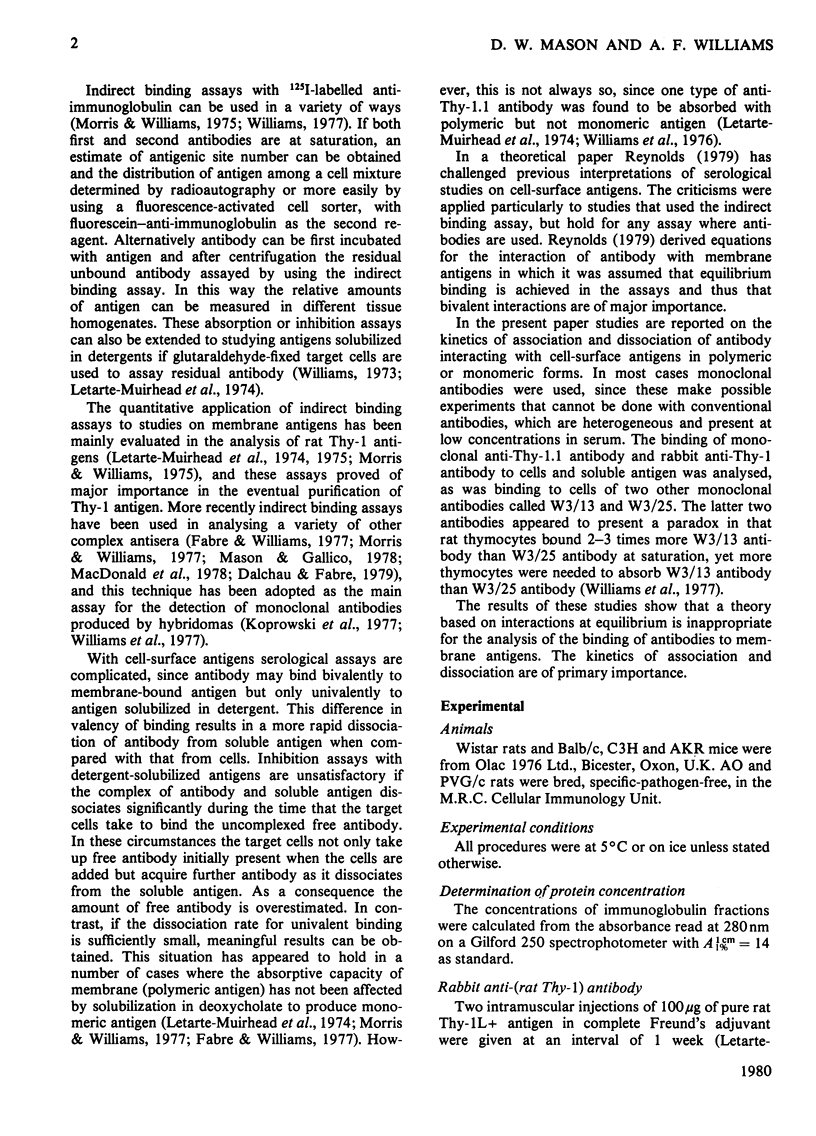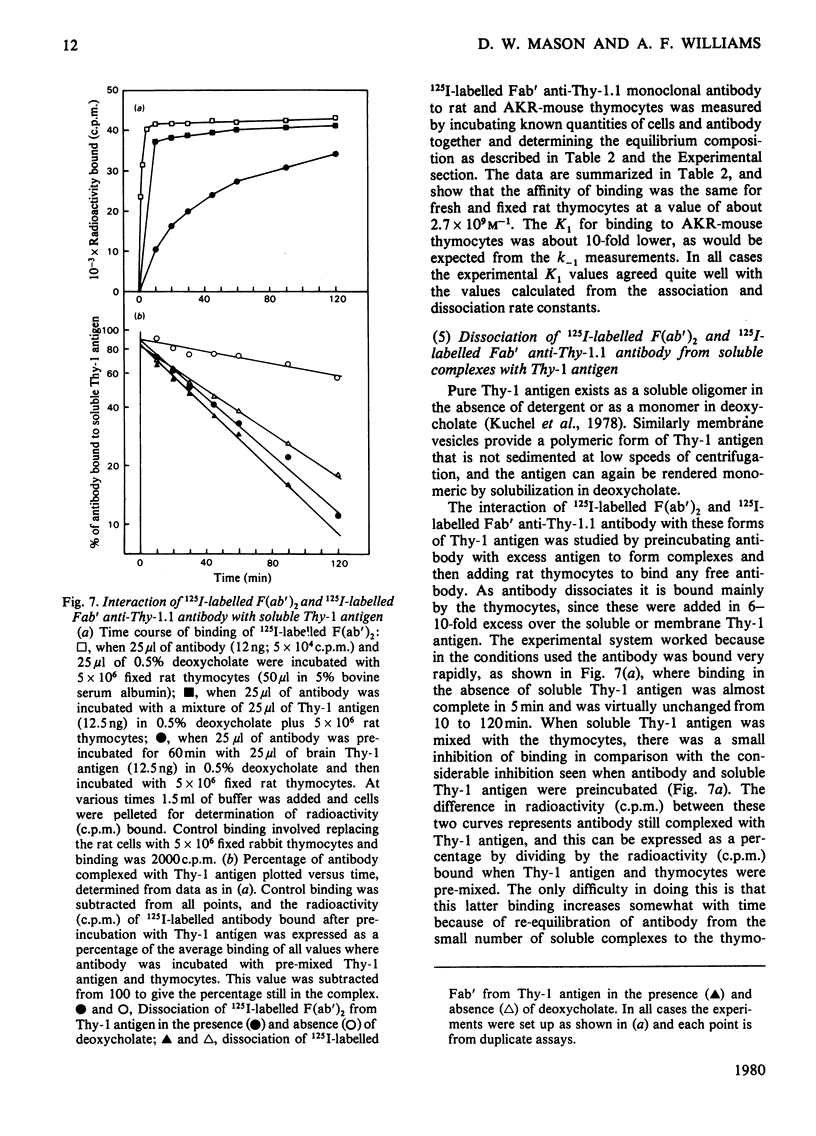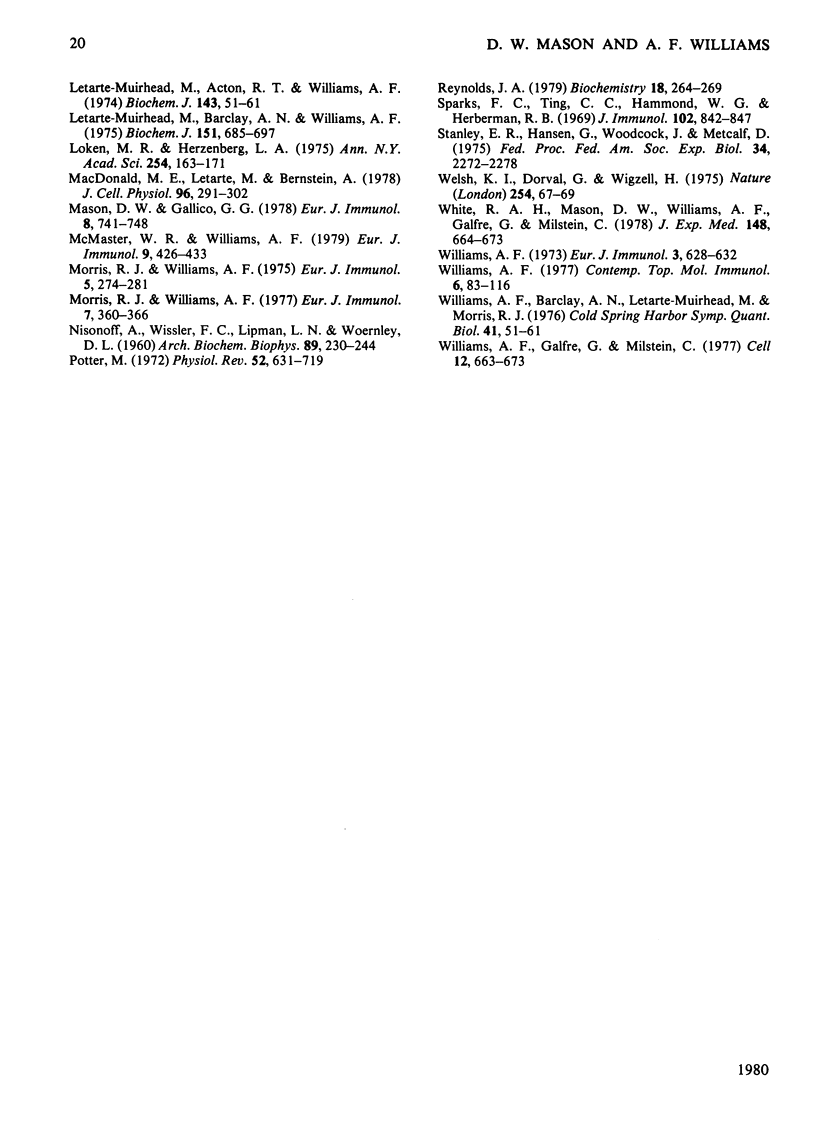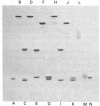Abstract
The reaction kinetics of 125I-labelled mouse monoclonal antibodies binding to three cell-surface antigens of rat thymocytes (Thy-1.1, W3/25) were studied. The differences between bivalent and univalent interactions were determined by using antibody in the F(ab')2 or Fab' form and by using antigen in polymeric or monomeric forms. Association rate constants (k+1), dissociation rate constants (k-1) and equilibrium constants were determined. Also, the dissociation kinetics of rabbit antibodies against rat Thy-1 antigen were studied. The major findings were as follows. (i) With F(ab')2 antibody there was no simple relationship between antigen density at the cell surface and extent of bivalent binding. Extensive univalent binding was observed unless the antibody had a high k-1 for the univalent interaction, in which case all binding was bivalent. (ii) k+1 values were similar for F(ab')2 or Fab' antibody, and for the different antibodies were in the range 0.8 x 10(5)--1.1 x 10(6) M-1.s-1. These differences were sufficient to affect the interpretation of serological assays with the different antibodies. (iii) Antibody bound bivalently dissociated much more slowly than that bound univalently. However, the k-1 values for the univalently bound antibody were sufficiently low in most cases that the lifetime of the univalent complex was similar to or greater than the time needed for the assay. Thus the results could be interpreted on the basis of irreversible reactions. The overall conclusion from the study is that for an understanding of the binding of antibody to cell-surface antigens the kinetics of the interaction are of major importance and theories based on equilibrium binding are inappropriate.
Full text
PDF



















Images in this article
Selected References
These references are in PubMed. This may not be the complete list of references from this article.
- Acton R. T., Morris R. J., Williams A. F. Estimation of the amount and tissue distribution of rat Thy-1.1 antigen. Eur J Immunol. 1974 Sep;4(9):598–602. doi: 10.1002/eji.1830040904. [DOI] [PubMed] [Google Scholar]
- Barclay A. N. A radioimmunoassay to recognise new brain differentiation antigens. Brain Res. 1977 Sep 9;133(1):139–143. doi: 10.1016/0006-8993(77)90054-3. [DOI] [PubMed] [Google Scholar]
- Barclay A. N., Letarte-Muirhead M., Williams A. F. Purification of the Thy-1 molecule from rat brain. Biochem J. 1975 Dec;151(3):699–706. doi: 10.1042/bj1510699. [DOI] [PMC free article] [PubMed] [Google Scholar]
- Barnstable C. J., Bodmer W. F., Brown G., Galfre G., Milstein C., Williams A. F., Ziegler A. Production of monoclonal antibodies to group A erythrocytes, HLA and other human cell surface antigens-new tools for genetic analysis. Cell. 1978 May;14(1):9–20. doi: 10.1016/0092-8674(78)90296-9. [DOI] [PubMed] [Google Scholar]
- DAY L. A., STURTEVANT J. M., SINGER S. J. The kinetics of the reactions between antibodies to the 2,4 dinitrophenyl group and specific haptens. Ann N Y Acad Sci. 1963 May 8;103:611–625. doi: 10.1111/j.1749-6632.1963.tb53721.x. [DOI] [PubMed] [Google Scholar]
- Dalchau R., Fabre J. W. Identification and unusual tissue distribution of the canine and human homologues of Thy-1 (theta). J Exp Med. 1979 Mar 1;149(3):576–591. doi: 10.1084/jem.149.3.576. [DOI] [PMC free article] [PubMed] [Google Scholar]
- Fabre J. W., Williams A. F. Quantitative serological analysis of a rabbit anti-rat lymphocyte serum and preliminary biochemical characterisation of the major antigen recognised. Transplantation. 1977 Apr;23(4):349–359. doi: 10.1097/00007890-197704000-00009. [DOI] [PubMed] [Google Scholar]
- Froese A. Kinetic and equilibrium studies on 2,4-Dinitrophenyl hapten-antibody systems. Immunochemistry. 1968 May;5(3):253–264. doi: 10.1016/0019-2791(68)90070-0. [DOI] [PubMed] [Google Scholar]
- Goldstein L. T., Klinman N. R., Manson L. A. A microtest radioimmunoassay for noncytotoxic tumor-specific antibody to cell-surface antigens. J Natl Cancer Inst. 1973 Nov;51(5):1713–1715. doi: 10.1093/jnci/51.5.1713. [DOI] [PubMed] [Google Scholar]
- Gopalakrishnan P. V., Karush F. Antibody affinity. VII. Multivalent interaction of anti-lactoside antibody. J Immunol. 1974 Sep;113(3):769–778. [PubMed] [Google Scholar]
- HUNTER W. M., GREENWOOD F. C. Preparation of iodine-131 labelled human growth hormone of high specific activity. Nature. 1962 May 5;194:495–496. doi: 10.1038/194495a0. [DOI] [PubMed] [Google Scholar]
- Harder F. H., McKhann C. F. Demonstration of cellular antigens on sarcoma cells by an indirect 125-I-labeled antibody technique. J Natl Cancer Inst. 1968 Feb;40(2):231–241. [PubMed] [Google Scholar]
- Jensenius J. C., Williams A. F. The binding of anti-immunoglobulin antibodies to rat thymocytes and thoracic duct lymphocytes. Eur J Immunol. 1974 Feb;4(2):91–97. doi: 10.1002/eji.1830040207. [DOI] [PubMed] [Google Scholar]
- Koprowski H., Gerhard W., Croce C. M. Production of antibodies against influenza virus by somatic cell hybrids between mouse myeloma and primed spleen cells. Proc Natl Acad Sci U S A. 1977 Jul;74(7):2985–2988. doi: 10.1073/pnas.74.7.2985. [DOI] [PMC free article] [PubMed] [Google Scholar]
- Kuchel P. W., Campbell D. G., Barclay A. N., Williams A. F. Molecular weights of the Thy-1 glycoproteins from rat thymus and brain in the presence and absence of deoxycholate. Biochem J. 1978 Feb 1;169(2):411–417. doi: 10.1042/bj1690411. [DOI] [PMC free article] [PubMed] [Google Scholar]
- Kulczycki A., Jr, Metzger H. The interaction of IgE with rat basophilic leukemia cells. II. Quantitative aspects of the binding reaction. J Exp Med. 1974 Dec 1;140(6):1676–1695. doi: 10.1084/jem.140.6.1676. [DOI] [PMC free article] [PubMed] [Google Scholar]
- Köhler G., Milstein C. Derivation of specific antibody-producing tissue culture and tumor lines by cell fusion. Eur J Immunol. 1976 Jul;6(7):511–519. doi: 10.1002/eji.1830060713. [DOI] [PubMed] [Google Scholar]
- Laemmli U. K. Cleavage of structural proteins during the assembly of the head of bacteriophage T4. Nature. 1970 Aug 15;227(5259):680–685. doi: 10.1038/227680a0. [DOI] [PubMed] [Google Scholar]
- Letarte-Muirhead M., Barclay A. N., Williams A. F. Purification of the Thy-1 molecule, a major cell-surface glycoprotein of rat thymocytes. Biochem J. 1975 Dec;151(3):685–697. doi: 10.1042/bj1510685. [DOI] [PMC free article] [PubMed] [Google Scholar]
- Loken M. R., Herzenber L. A. Analysis of cell populations with a fluorescence-activated cell sorter. Ann N Y Acad Sci. 1975 Jun 30;254:163–171. doi: 10.1111/j.1749-6632.1975.tb29166.x. [DOI] [PubMed] [Google Scholar]
- MacDonald M. E., Letarte M., Berstein A. Erythrocyte membrane antigen expression during Friend cell differentiation: analysis of two non-inducible variants. J Cell Physiol. 1978 Sep;96(3):291–301. doi: 10.1002/jcp.1040960304. [DOI] [PubMed] [Google Scholar]
- Mason D. W., Gallico G. G. Tissue distribution and quantitation of Ia-like antigens in the rat. Eur J Immunol. 1978 Oct;8(10):741–748. doi: 10.1002/eji.1830081013. [DOI] [PubMed] [Google Scholar]
- McMaster W. R., Williams A. F. Identification of Ia glycoproteins in rat thymus and purification from rat spleen. Eur J Immunol. 1979 Jun;9(6):426–433. doi: 10.1002/eji.1830090603. [DOI] [PubMed] [Google Scholar]
- Morris R. J., Williams A. F. Antigens on mouse and rat lymphocytes recognized by rabbit antiserum against rat brain: the quantitative analysis of a xenogeneic antiserum. Eur J Immunol. 1975 Apr;5(4):274–281. doi: 10.1002/eji.1830050412. [DOI] [PubMed] [Google Scholar]
- Morris R. J., Williams A. F. Serological and preliminary biochemical characteristics of a T lymphocyte differentiation antigen detected by rabbit antiserum to rat thymocyte membranes. Eur J Immunol. 1977 Jun;7(6):360–366. doi: 10.1002/eji.1830070607. [DOI] [PubMed] [Google Scholar]
- Muirhead M. L., Action R. T., Williams A. F. Preliminary characterization of Thy-1.1 and Ag-B antigens from rat tissues solubilized in detergents. Biochem J. 1974 Oct;143(1):51–61. doi: 10.1042/bj1430051. [DOI] [PMC free article] [PubMed] [Google Scholar]
- NISONOFF A., WISSLER F. C., LIPMAN L. N., WOERNLEY D. L. Separation of univalent fragments from the bivalent rabbit antibody molecule by reduction of disulfide bonds. Arch Biochem Biophys. 1960 Aug;89:230–244. doi: 10.1016/0003-9861(60)90049-7. [DOI] [PubMed] [Google Scholar]
- Potter M. Immunoglobulin-producing tumors and myeloma proteins of mice. Physiol Rev. 1972 Jul;52(3):631–719. doi: 10.1152/physrev.1972.52.3.631. [DOI] [PubMed] [Google Scholar]
- Reynolds J. A. Interaction of divalent antibody with cell surface antigens. Biochemistry. 1979 Jan 23;18(2):264–269. doi: 10.1021/bi00569a004. [DOI] [PubMed] [Google Scholar]
- Sparks F. C., Ting C. C., Hammond W. G., Herberman R. B. An isotopic antiglobulin technique for measuring antibodies to cell-surface antigens. J Immunol. 1969 Apr;102(4):842–847. [PubMed] [Google Scholar]
- Stanley E. R., Hansen G., Woodcock J., Metcalf D. Colony stimulating factor and the regulation of granulopoiesis and macrophage production. Fed Proc. 1975 Dec;34(13):2272–2278. [PubMed] [Google Scholar]
- Welsh K. I., Dorval G., Wigzell H. Rapid quantitation of membrane antigens. Nature. 1975 Mar 6;254(5495):67–69. doi: 10.1038/254067a0. [DOI] [PubMed] [Google Scholar]
- White R. A., Mason D. W., Williams A. F., Galfre G., Milstein C. T-lymphocyte heterogeneity in the rat: separation of functional subpopulations using a monoclonal antibody. J Exp Med. 1978 Sep 1;148(3):664–673. doi: 10.1084/jem.148.3.664. [DOI] [PMC free article] [PubMed] [Google Scholar]
- Williams A. F., Barclay A. N., Letarte-Muirhead M., Morris R. J. Rat thy-1 antigens from thymus and brain: their tissue distribution, purification, and chemical composition. Cold Spring Harb Symp Quant Biol. 1977;41(Pt 1):51–61. doi: 10.1101/sqb.1977.041.01.009. [DOI] [PubMed] [Google Scholar]
- Williams A. F. Differentiation antigens of the lymphocyte cell surface. Contemp Top Mol Immunol. 1977;6:83–116. doi: 10.1007/978-1-4684-2841-4_3. [DOI] [PubMed] [Google Scholar]
- Williams A. F., Galfrè G., Milstein C. Analysis of cell surfaces by xenogeneic myeloma-hybrid antibodies: differentiation antigens of rat lymphocytes. Cell. 1977 Nov;12(3):663–673. doi: 10.1016/0092-8674(77)90266-5. [DOI] [PubMed] [Google Scholar]
- Williams J. D. Screening for bacteriuria; present status and future prospects. J Ir Med Assoc. 1973 Nov 24;66(22):628–632. [PubMed] [Google Scholar]



